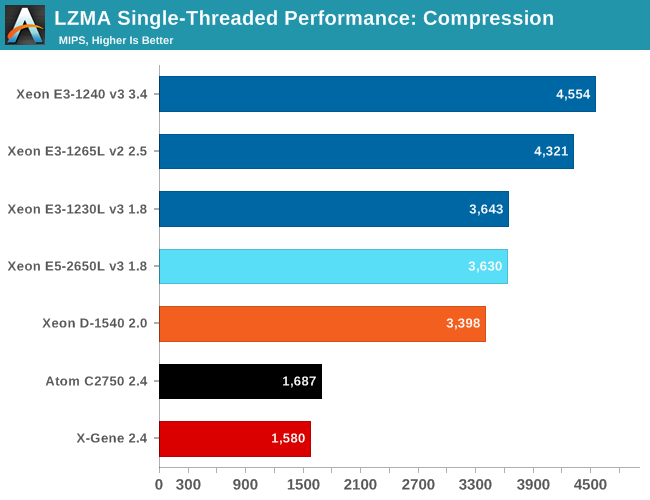The Intel Xeon D Review: Performance Per Watt Server SoC Champion?
by Johan De Gelas on June 23, 2015 8:35 AM EST- Posted in
- CPUs
- Intel
- Xeon-D
- Broadwell-DE
Single-Threaded Integer Performance
The LZMA compression benchmark only measures a part of the performance of some real-world server applications (file server, backup, etc.). The reason why we keep using this benchmark is that it allows us to isolate the "hard to extract instruction level parallelism (ILP)" and "sensitive to memory parallelism and latency" integer performance. That is the kind of integer performance you need in most server applications.
One more reason to test performance in this manner is that the 7-zip source code is available under the GNU LGPL license. That allows us to recompile the source code on every machine with the -O2 optimization with gcc 4.8.2.

The Xeon E5-2650L Haswell core is only able to boost to 2.5 GHz, while the Xeon D has a newer core (Broadwell) and is capable of 2.6 GHz. Still, the Xeon E5 is 6% faster. The most likely explanation is that the Xeon E5-2650L (65W TDP) keeps turboboost higher for a longer time than the Xeon D (45W TDP).
The Xeon D and Atom C2750 run at the same clockspeed in this single threaded task (2.6 GHz), but you can see how much difference a wide complex architecture makes. The Broadwell Core is able to run about twice as many instructions in parallel as the Silvermont core. The Haswell/Broadwell core results clearly show that well designed wide architectures remain quite capable, even in "low ILP" (Instruction Level Parallelism) code.
Let's see how the chips compare in decompression. Decompression is an even lower IPC (Instructions Per Clock) workload, as it is pretty branch intensive and depends on the latencies of the multiply and shift instructions.

The Xeon E5 runs at 2.5 GHz, the Xeon D at 2.6 GHz, the Xeon E3-1230L at 2.8 GHz, The Xeon E3-1265L can reach 3.7 GHz. The decompression results follow the same logic. There does not seem to be a difference between a Broadwell, Haswell or Ivy Bridge core: performance is almost linear with (turboboost) clockspeed. The only exception is the Xeon E3-1240 which turboboost to 3.8 GHz, but outperforms the other by a larger than expected. The explanation is pretty simple: the higher TDP (80 W) allows the chip to sustain turbo boost clock speeds for much longer.










90 Comments
View All Comments
AkulaClass - Tuesday, June 23, 2015 - link
Nice stuff. Realy good to see them bringing power consumption down pr. Performance.WorldWithoutMadness - Tuesday, June 23, 2015 - link
Nice way to confuse people. Codename Yosemiteretrospooty - Tuesday, June 23, 2015 - link
Who would this confuse? Apple fans because of the OS witht he same codename?LOL. Believe me they don't know, or care... Most of them aren't even aware of what a "server" chip is, or even what a "server" is used for.
IanHagen - Tuesday, June 23, 2015 - link
Rails developer checking in to remind you that a great chunk of the Rails community develop using OS X to deploy on Linux and hence is aware of "server chips". Even though you said that "most" Apple users don't know what a server chip is and that's accurate, the same could be said about Windows or even Linux common users. Stop patronizing.All being said, I agree with you. Who could possibly confound the Xeon D's codename coincides with OS X's 10.10 name?
WinterCharm - Tuesday, June 23, 2015 - link
First of all, your implication that apple fans don't know jack shit about servers is a broad generalization, and a stupid one at that.Second of all, anyone who knows enough to even consider buying a Xeon and a motherboard that supports it and the ECC memory, probably knows enough to not get confused. And plenty of mac users know what server chips are and what they're used for.
Nice trolling though.
adithyay328 - Tuesday, August 25, 2015 - link
That's not entirely true, but I will agree that people a lot of the people who use Apples( No discrimination intended) only continue to use Apple due to their lack of tech knowledge( like knowing Android is the king :) . And, yes, they probably won;t know what servers even are.jeffsci - Monday, June 29, 2015 - link
Geographic code names are the norm in the computing industry (I think because they cannot be copyrighted) and they end up being reused. For example, Intel Seattle is/was a motherboard and AMD Seattle is/was an ARM64 processor. See https://en.wikipedia.org/wiki/List_of_Intel_codena... https://en.wikipedia.org/wiki/List_of_Microsoft_co... etc. if you would like to look for more examples :-)RaiderJ - Tuesday, June 23, 2015 - link
Any places in the US that the motherboard is available for purchase? Quick checks looks like it's mostly sold out or otherwise unavailable?ats - Tuesday, June 23, 2015 - link
Availability comes and goes. Xeon D has been a big hit in the large scale deployment markets and they've been soaking up a lot of demand for it, both bare and combined on motherboards like the supermicro offerings severely limiting retail availability. But it is available in retail but quantities are limited. Quite a number of people over at servethehome have gotten their hands on them. If you want one, you'll likely have to keep checking the major sites like newegg, amazon, et al for them to come back in stock. Retail boards are generally in the $800-1000 range atm (basically going for full list but then again bare motherboards with 10gbe tend to go for 600+ so its still a good buy and simple new 10gbe cards tend to go for $300-500).ToTTenTranz - Tuesday, June 23, 2015 - link
How come they call this a SoC if there's no integrated module to drive even a simple display, and they apparently need a discrete PCIe graphics card for that D-SUB output?